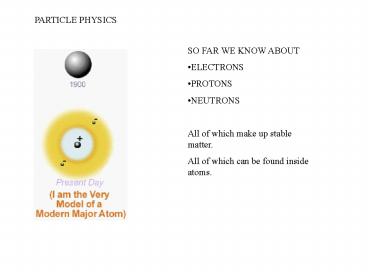PARTICLE PHYSICS PowerPoint PPT Presentation
1 / 16
Title: PARTICLE PHYSICS
1
PARTICLE PHYSICS
- SO FAR WE KNOW ABOUT
- ELECTRONS
- PROTONS
- NEUTRONS
- All of which make up stable matter.
- All of which can be found inside atoms.
2
We know about the Coulomb Force
And the Strong Force
3
Several New Particles were discovered in the
1930s that were not atoms !! (not made up of
protons and neutrons)
- POSITRON (antimatter)
- This particle was theorized before it was
predicted. Dirac applied Special Relativity to
Schrodingers Wave Equation for free electrons.
Both positive and negative solutions were
revealed!! - The positron has equal rest mass to the electron
but opposite charge and spin. It was detected by
Anderson in the early 30s at high altitude
observing cosmic rays coming from space.
4
Particle Detectors
- Geiger counter
- Tube is filled with a certain type of gas
- Potential Difference of 1000V is setup between
the anode wire and wall. Just below the
ionization potential of the gas - An incoming charged particle or photon easily
ionizes the gas causing a shower of electrons
registered as a current pulse
5
CLOUD CHAMBER
6
Detection of the positron.
Condensed bubbles reveal the path of 2 particles,
both originating from the same point Questions
What caused the pair? Why do they curve ? Why do
they spiral?
7
- Several other particles were discovered by cosmic
ray events at high altitudes those included - The muon and its corresponding antiparicle
- The pion and its corresponding antiparticle.
- Both these particles are unstable
8
PARTICLE ACCELERATORSThe need for speed
(energy)
In the 1950s Physicists were beginning to
discover more particles with the help of
accelerators. Charged particles, typically
protons or electrons, are accelerated at very
high speeds and slammed into a target particle
typically other protons and / or electrons. The
result is a showering of new particles
9
(No Transcript)
10
(No Transcript)
11
Particle production often results in new
particles that are very unstable and live for
only very brief periods of time. Note the KE of
the accelerated proton has gone into producing
particles with a combined rest mass often many
times greater than the rest mass of the
accelerated proton. (E mc2)
12
By the early 1960s, physicists had discovered
close to 100 new particles most of which were
extremely unstable. A classification process was
beginning to take shape, so that patterns could
be obtained with the hope of learning how these
particles are formed and why they interact the
way they do.
13
Note the three major groups. The obvious
difference is the mass range for each group.
Lepton slight Baryon heavy Meson
middle
14
- Classification is based on several conservation
laws that govern particle interactions. - All particle interactions obey conservation of
charge , mass/energy and momentum - HOWEVER
- Certain patterns began to appear between observed
particle interactions - e.g.
- p p p p p p
(occurred) - p p p n (occurred)
- p p p p n (did not occur)
- Another conservation quantity was introduced to
describe allowable interactions . BARYON NUMBER
15
- Similarly with Lepton interaction
- Consider the following
- m g (does not occur)
- Whereas
- p m nm (does occur)
LEPTON NUMBER was introduced to describe
allowable lepton interactions. Consider the
following common processes m- e- ne nm
(muon decay)
n p e- ne (beta negative
decay, con. of B and L )
p n e ne (beta negative decay,
con of B and L)
16
We can only get a better appreciation for Baryon
Number and Lepton Number if we know what causes
these interactions.

